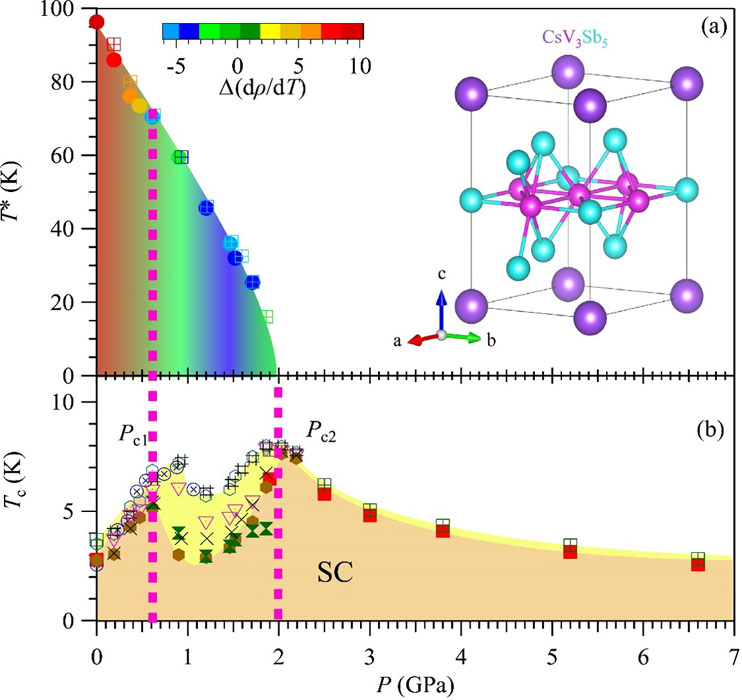Double Superconducting Dome and Triple Enhancement of Tc in the Kagome Superconductor CsV3Sb5 under High Pressure
Uwatoko Group
The newly discovered kagome metals AV3Sb5 (A = K, Rb, Cs) have aroused tremendous research interest as a novel platform to study the interplay between nontrivial band topology, superconductivity (SC) and charge-density-wave (CDW) order [1-4]. At ambient conditions, these materials crystallize into a layered structure with hexagonal symmetry (space group P6/mmm), inset of Fig. 1(a), consisting of A layer and V-Sb slab stacked alternatively along the c-axis. The most prominent feature of this structure is the presence of quasi-2D ideal kagome layers of V ions coordinated by Sb. These compounds are metallic and enter a superconducting ground state below Tc = 0.93, 0.92, and 2.5 K for A= K, Rb, and Cs [2-4], respectively. In the normal state, their transport and magnetic properties exhibit a clear anomaly at T* = 78, 104, and 94 K, respectively, due to the formation of CDW-like order as revealed by the x-ray diffraction and scanning tunning microscopy measurements [2-4]. The charge order in KV3Sb5 has been found to display a chiral anisotropy [5], which can lead to giant anomalous Hall effect in the absence of magnetic order or local moments [6,7]. It was also argued as a strong precursor of unconventional SC. Moreover, angle-resolved photoemission spectroscopy measurements and density-functional-theory calculations have characterized their normal state as a Z2 topological metal with multiple Dirac nodal points near the Fermi level [1,4], consistent with the observations of Shubnikov-de Haas quantum oscillations and small Fermi surfaces (FSs) with low effective mass in RbV3Sb5 [3].

Fig. 1. Temperature-pressure phase diagram of CsV3Sb3. Pressure dependence of the transition temperatures for (a) the CDW-like order and (b) superconductivity. The color scale in (a) represents the sign of Δ(dρ/dT) around T*, which changes sign near Pc1 due to the modification of CDW order. Inset of (a) shows the crystal structure of CsV3Sb3. The yellow region between Pc1 and Pc2 in (b) corresponds to a relatively broad superconducting transition.
At present, the topologically related phenomena and SC have been actively studied in these AV3Sb5 compounds, but the rich physics related to the electron correlation, especially the relationship between the intertwined electronic orders, has been barely revealed. In this regard, it is interesting to unveil the correlation between the CDW-like order and SC commonly observed in these AV3Sb5 materials. Thus, we have chosen to study CsV3Sb5 with the highest Tc among this series of compounds by applying a high-pressure approach, which has been widely used in disentangling the competing electronic orders of strongly correlated metals. The interplay between CDW and SC in CsV3Sb5 was studied via measurements of resistivity, DC and AC magnetic susceptibility under various pressures up to 6.6 GPa [8]. We find that the CDW transition decreases with pressure and experience a subtle modification at Pc1 ≈ 0.6-0.9 GPa before it vanishes completely at Pc2 ≈ 2 GPa. Correspondingly, Tc(P) displays an unusual M-shaped double dome with two maxima around Pc1 and Pc2, respectively, leading to a tripled enhancement of Tc to about 8 K at 2 GPa. The obtained temperature-pressure phase diagram, Fig. 1, resembles those of many unconventional superconductors, illustrating an intimated competition between CDW-like order and SC. The competition is found to be particularly strong for the intermediate pressure range Pc1 ≤ P ≤ Pc2 as evidenced by the broad superconducting transition and reduced superconducting volume fraction. The modification of CDW order around Pc1 has been discussed based on the band structure calculations. Our work not only demonstrates the potential to raise Tc of the V-based kagome superconductors, but also offers more insights into the rich physics related to the electron correlations in this novel family of topological kagome metals.
References
- [1] B. R. Ortiz, L. C. Gomes, J. R. Morey et al., Phys. Rev. Mater. 3, 094407 (2019).
- [2] B. R. Ortiz, E. Kenney, P.M. Sarte et al., Phys. Rev. Mater. 5, 034801 (2021).
- [3] Q.W. Yin, Z. J. Tu, C. S. Gong et al., Chin. Phys. Lett. 38, 037403 (2021).
- [4] B. R. Ortiz, S. M. L. Teicher, Y. Hu et al., Phys. Rev. Lett. 125, 247002 (2020).
- [5] Y. X. Jiang, J. X. Yin, M. M. Denner et al., Nature Mater. 20, 1353 (2021).
- [6] S. Y. Yang, Y. J. Wang, B. R. Ortiz et al., Sci. Adv. 6, eabb6003 (2020).
- [7] E. M. Kenney, B. R. Ortiz, C. N. Wang et al., J. Phys. Condens. Matter. 33, 235801 (2021).
- [8] K. Y. Chen, N. N. Wang, Q. W. Yin et al., Phys. Rev. Lett. 126, 247001 (2021).
